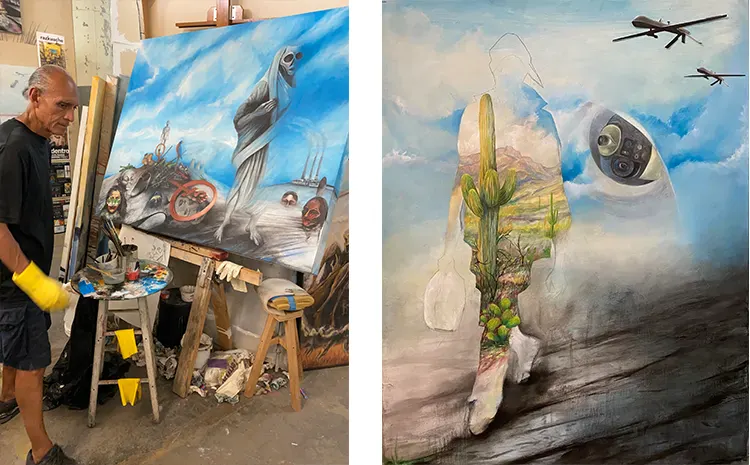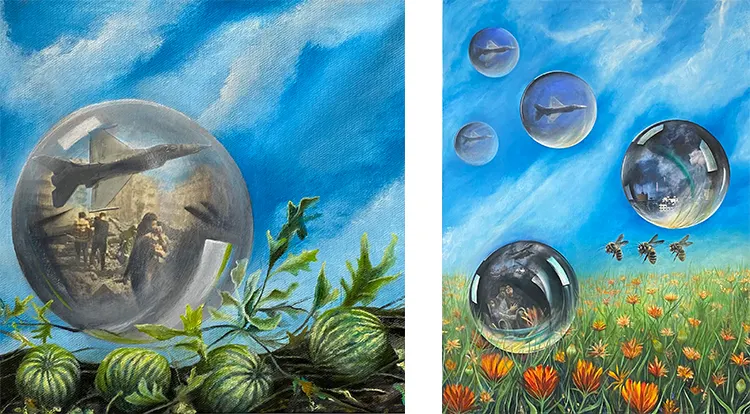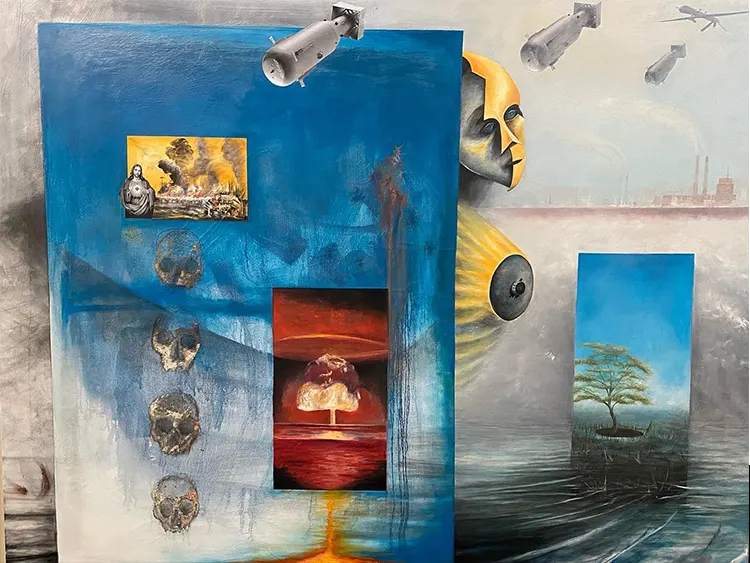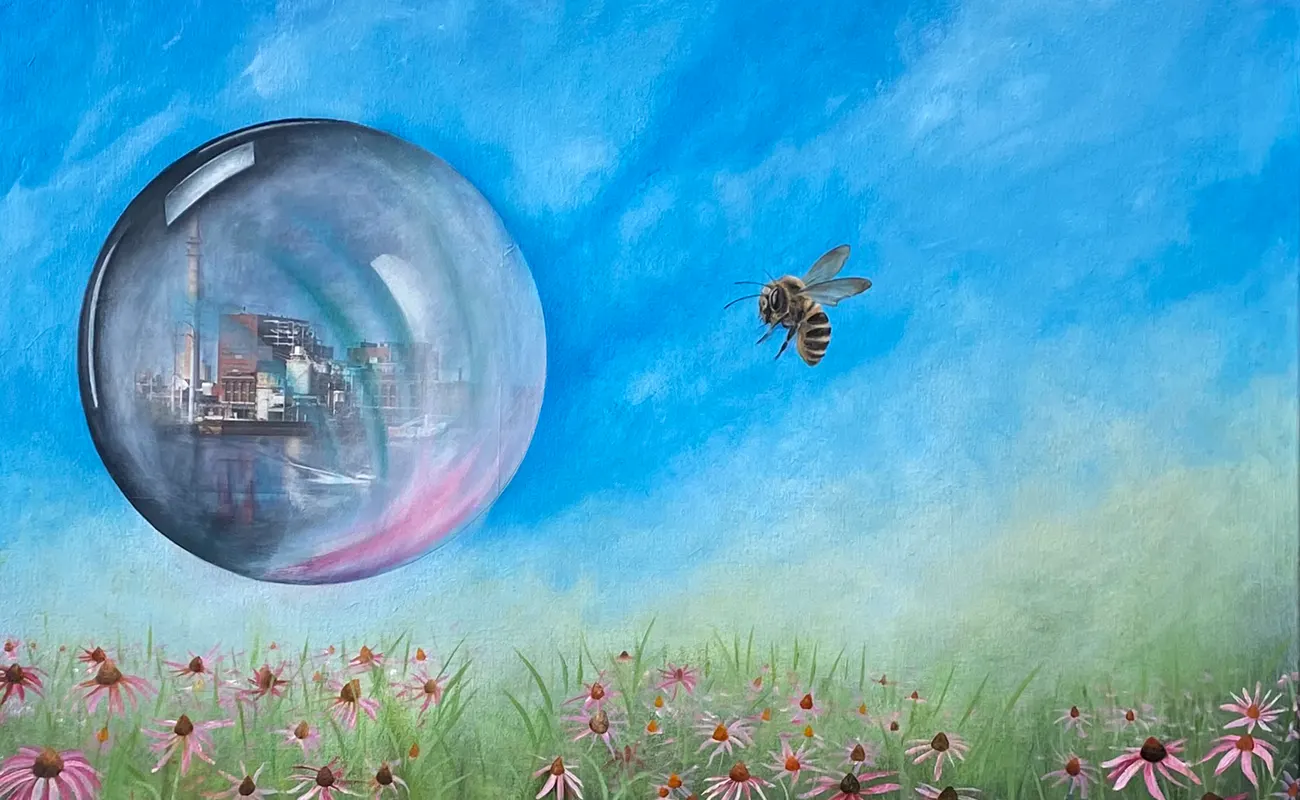“I use visual elements to talk about the political, economic, social, and environmental prejudice that are taking place around the globe, especially in my own country.”
The Fusion of Cultures and Struggles
Ricardo Santos Hernández‘s artistry is a vivid tapestry woven from his diverse cultural heritage, reflecting the vibrant yet challenging experiences of his life. Growing up in the border cities of Nogales, Arizona, and Nogales, Sonora, Mexico, Hernández’s mixed Yaqui and Chicano background deeply influenced his artistic voice. The artist masterfully integrates the intuitive visual elements of Native heritage with the resilience and struggles of a Mexican woman in the United States. His works are not just visual feasts but narratives that speak of survival, identity, and the nuanced reality of living as ‘the other.’
The compelling narrative of Hernández’s life story enriches the fabric of his art. From a young age, he was drawn to the world of creativity, engaging in drawing and crafting objects from found materials. Yet, life’s circumstances nudged him towards a different path initially, where he contributed to his family’s financial stability by becoming a schoolteacher. However, his passion for art remained unquenched, leading him to pursue formal education in the field in his mid-30s. This journey of self-discovery and dedication culminated in a master’s degree in painting and drawing, marking the beginning of Hernández’s professional artistic voyage.

Ricardo Santos Hernández: A Studio of Inspiration and Reflection
Ricardo Santos Hernández’s studio, nestled in an industrial zone in Chicago, is more than just a physical space. It is a sanctuary where inspiration and creativity converge, allowing Hernández to delve deeply into his artistic pursuits. This environment, devoid of distractions, is where he engages with his themes, reflecting on global issues like migration, war, and technology’s impact on humanity. His studio, filled with plants and accompanied by music or podcasts, is not just a workspace but a cradle of creativity that fuels his artistic endeavors.
The disciplined routine Hernández follows in his studio is a testament to his dedication to his craft. His engagement with diverse materials, ranging from oils to recycled paper and metals, showcases his versatility and willingness to experiment. Whether he’s painting, sculpting, or working on installations, Hernández’s creative process is a journey of exploration and expression. His themes, often challenging and provocative, invite viewers to engage with complex global issues, making his studio not just a place of creation but a hub of intellectual and emotional exploration.

The Resonance of Influences: Echoes of the Past in Modern Struggles
Ricardo Santos Hernández draws profound inspiration from historical figures and art that resonate with his ethos. Esteemed artists like Francisco Goya, Francis Bacon, and José Clemente Orozco, along with local Chicago talent Carlos Cortez, significantly influence Hernández’s work. These artists, known for their compelling visual narratives that critique the injustices and turmoil of their times, find a kindred spirit in Hernández. His admiration for these figures is not merely about their artistic prowess but their ability to capture and communicate the societal and political upheavals of their eras through their art.
One piece that holds particular significance for Hernández is José Clemente Orozco’s “El Hombre de Fuego” (The Man of Flames), a mural that depicts the brutal history and lingering injustices in Mexico and Latin America. This artwork is not just a source of inspiration but a mirror reflecting Hernández’s own commitment to addressing similar themes in his work. His connection to “El Hombre de Fuego” transcends mere artistic appreciation—it’s a link to a shared language of resistance and a reminder of the power of art to challenge and provoke thought about prevailing injustices.

Ricardo Santos Hernández: Sculpting Messages
In the heart of the desert, where the US-Mexico border delineates more than just geographical boundaries, Ricardo Santos Hernández envisions a project that embodies the ceaseless spirit of migration. He dreams of creating two colossal migrant/Native figures, standing tall on either side of the border wall, crafted from the very materials discarded by construction efforts in the desert. This vision is not just an artistic endeavor but a powerful statement on the natural human inclination to migrate, an instinct that no physical barrier can deter.
Hernández’s proposed installation transcends traditional artistic boundaries, embedding a profound narrative within the landscape itself. The figures, facing each other across the imposing metal barrier, symbolize a conversation, a silent yet potent dialogue about identity, division, and the enduring human spirit. Through this ambitious project, Hernández aims to weave a visual story that speaks to the shared history and interconnected fate of the peoples on both sides of the border. It’s a testament to his belief in art’s capacity to not only reflect reality but to challenge it, inviting onlookers to ponder the deeper meanings of barriers, both physical and metaphorical, in our interconnected world.






